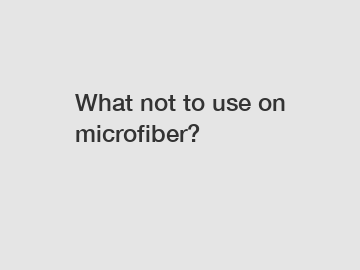What not to use on microfiber?
Welcome to our blog, where we explore the dos and don'ts of microfiber care. In this article, we'll focus on the crucial topic of what not to use on microfiber. As experts in the field, we understand the importance of preserving the integrity of your soft surfaces. By adhering to these guidelines, you can avoid inadvertently damaging your cherished microfiber items. Let's delve into the specifics!
1. Say No to Bleach:
Microfiber is known for its exceptional absorbency and durability. However, bleach can be detrimental to its fibers. When exposed to bleach, the fabric may become discolored, lose its softness, and even develop holes. To keep your microfiber items in top condition, steer clear of any form of bleach or bleach-based products.

2. Avoid Harsh Chemical Cleaners:
While microfiber is resilient, certain harsh chemical cleaners can cause irreversible damage. Cleaning agents containing ammonia, acetone, and solvents can break down the fibers and compromise their integrity. Opt for gentle, pH-neutral cleaners designed specifically for delicate fabrics instead. They are milder yet highly effective in keeping your microfiber surfaces clean and fresh.
3. Skip Abrasive Tools:
Maintaining microfiber surfaces often requires regular dusting and stain removal. However, it's crucial to avoid abrasive tools during this process. Wire brushes, stiff bristle brushes, and scrub pads can tear or fray the fibers, leading to a shorter lifespan for your microfiber items. Instead, opt for soft, microfiber-friendly brushes or lint-free cloths to tackle any cleaning or maintenance tasks.
4. Ditch Excessive Heat:
Microfiber is a fantastic fabric that dries quickly, making it perfect for busy households. However, it's important to be mindful of the drying process. High heat, such as that from hairdryers or radiators, can damage the fabric by causing it to shrink or melt. Always air dry or use a low heat setting when necessary to preserve your microfiber's softness and appearance.
5. Steer Clear of Velcro and Hook-and-Loop Fasteners:
Velcro and hook-and-loop fasteners are incredibly useful but can wreak havoc on microfiber. The tiny hooks found in these fasteners can snag and pull at the fabric, creating unsightly damage. Avoid storing or cleaning microfiber items alongside anything that contains these types of closures. By doing so, you'll protect your fabric from unnecessary wear and tear.
6. Banish Oil-Based Products:
Microfiber has a high affinity for oil and is often used in cleaning supplies to attract and hold onto dirt and grime. However, it's important to avoid using any oil-based products directly on microfiber surfaces. These oils can become embedded in the fabric, leading to stains or a greasy feel. Stick to water-based cleaners to effectively tackle any spills or stains without harming your microfiber.
Conclusion:
By now, you should have a solid understanding of what not to use on microfiber. To keep your microfiber surfaces looking and feeling their best, avoiding bleach, harsh chemicals, abrasive tools, excessive heat, Velcro, and oil-based products is essential. With proper care, your microfiber items will continue to provide comfort, style, and durability for many years to come. So, go ahead and enjoy the softness and versatility of microfiber fabrics with peace of mind!
Contact us to discuss your requirements of china a microfiber cloth manufacturer, china towel manufacturer, custom microfiber towels. Our experienced sales team can help you identify the options that best suit your needs.


